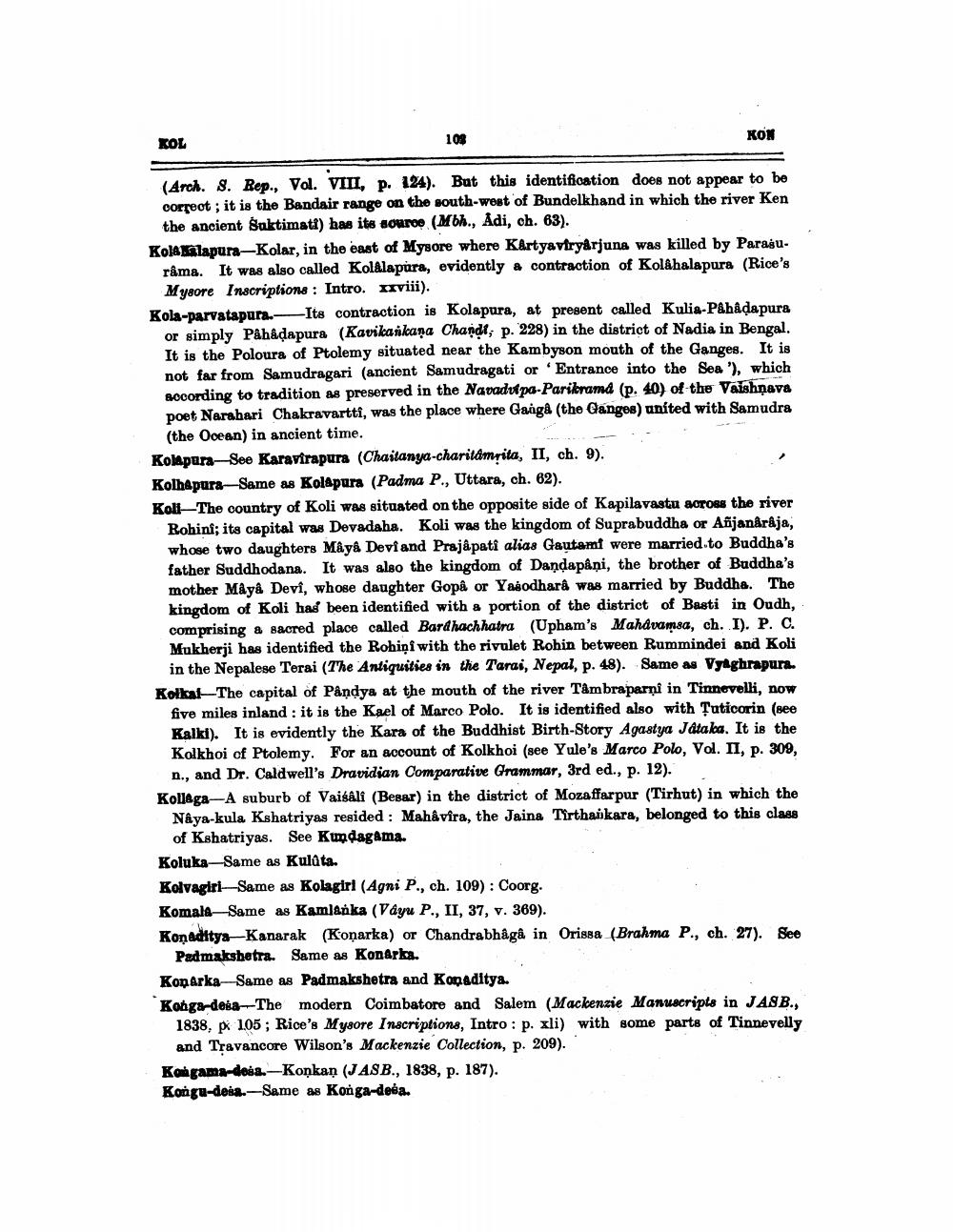________________
KOL
108
кон
(Arch. 8. Rep., Vol. VIII, p. 124). But this identification does not appear to be correot : it is the Bandair range on the south-west of Bundelkhand in which the river Ken
the ancient Saktimati) has its source (Mbh., Adi, ch. 63). Kolalalapura-Kolar, in the east of Mysore where Kartyavfry&rjuna was killed by Paragu
råma. It was also called Kolalapira, evidently a contraction of Kolkhalapura (Rice's
Mysore Inscriptions : Intro. xxviii). Kola-parystapur- Its contraction is Kolapura, at present called Kulis-P&hadapura or simply Påhådapura (Kavikaikana Chandi; p. 228) in the district of Nadia in Bengal. It is the Polours of Ptolemy situated near the Kambyson mouth of the Ganges. It is not far from Samudragari (ancient Samudragati or 'Entrance into the Sea '), which socording to tradition as preserved in the Navadupa-Parikramd (p. 40) of the Vaishnava poet Narahari Chakravartti, was the place where Gang (the Ganges) united with Samudra
(the Ocean) in ancient time. Kolapura-See Karavirapura (Chaitanya-charitampita, II, ch. 9). Kolhapura-Same as Kolapura (Padma P., Uttara, ch. 62). Koll—The country of Koli was situated on the opposite side of Kapilavastu across the river
Rohini; its capital was Devadaha. Koli was the kingdom of Suprabuddha or Asjanârâja, whose two daughters Maya Devi and Prajapati alias Gautam were married to Buddha's father Suddhodana. It was also the kingdom of Dandapâni, the brother of Buddha's mother Mâyâ Devi, whose daughter Gopâ or Yasodharâ was married by Buddha. The kingdom of Koli has been identified with a portion of the district of Basti in Oudh, comprising a sacred place called Bardhachhatra (Upham's Mahavamsa, ch. I). P. C. Mukherji has identified the Robini with the rivulet Rohin between Rummindei and Koli
in the Nepalese Terai (The Antiquities in the Tarai, Nepal, p. 48). Same as Vy ghrapura. Kolkat—The capital of Påndya at the mouth of the river Tâmbraparņi in Tinnevelli, now
five miles inland : it is the Kael of Marco Polo. It is identified also with Tuticorin (see Kalkl). It is evidently the Kara of the Buddhist Birth-Story Agastya Jataka. It is the Kolkhoi of Ptolemy. For an account of Kolkhoi (see Yule's Marco Polo, Vol. II, p. 309,
n., and Dr. Caldwell's Dravidian Comparative Grammar, 3rd ed., p. 12). Kollaga—A suburb of Vaisali (Besar) in the district of Mozaffarpur (Tirhut) in which the
Nâya-kula Kshatriyas resided : Mahåvira, the Jaina Tirthaikara, belonged to this class
of Kshatriyas. See Kum dagama. Koluka-Same as Kulata. Kolvagiri-Same as Kolagiri (Agni P., ch. 109): Coorg. Komala-Same as Kamlanka (Vayu P., II, 37, v. 369). Konaditya-Kanarak (Konarka) or Chandrabhågå in Orissa (Brahma P., ch. 27). See
Padmaksbetra. Same as Konarka. Konarka-Same as Padmakshetra and Komaditya. Konga desa---The modern Coimbatore and Salem (Mackenzie Manuscripts in JASB.,
1838, p 105 ; Rice's Mysore Inscriptions, Intro : p. xli) with some parts of Tinnevelly
and Travancore Wilson's Mackenzie Collection, p. 209). Kongama-dosa.-Konkan (JASB., 1838, p. 187). Kongu-desa-Same as Konga-desa.




